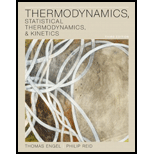
Interpretation: The value for
Concept Introduction: For ideal gas, the relation between
Where
Interpretation: The value for
Concept Introduction: For van der Waals equation, the relation between
Where
Want to see the full answer?
Check out a sample textbook solution
Chapter 2 Solutions
Thermodynamics, Statistical Thermodynamics, & Kinetics
- Which of the following quantities can be taken to be independent of temperature? independent of pressure? (a) H for a reaction (b) S for a reaction (c) G for a reaction (d) S for a substancearrow_forwardIn the equation w = P V, why is there a negative sign?arrow_forwardWhat properties of a nonideal gas do the Vander Waals constants represent?arrow_forward
- Why is equation2.37 written interms of CV and Cp and not c-v and c-p ?arrow_forwardUse the data in Table 2.2 to determine Hp T for Ar at 0C and 1atm. Make any reasonable assumptions necessary.arrow_forwardDetermine an expression for V/T p, n in terms of and . Does the sign on the expression make sense in terms of what you know happens to volume as temperature changes?arrow_forward
- Two ideal gas systems undergo reversible expansion under different conditions starting from the same P and V. At the end of the expansion, both systems have the same volume, but one has a lower pressure than the other. Provide an explanation for this difference by describing how the two processes could have differed.arrow_forward5. Calculate the work for the expansion of 3 moles of B;Hs at 40"C from 2.74 L to 3.89 L using van der Waals equation. The correction for intermolecular forces (a) is 6.048 bar L?/mol and the adjustment factor of the volume (b) is 0.07437 L/mol. The general equation for van der Waals is written below: + a =. A. 2352.2376J B. -2352.2376 J C. 2118.1071J D. -2118.1071 Jarrow_forwardA sample of 2.2 mol CO2(g) is originally confined in 15 dm3 at 280 K and then undergoes adiabatic expansion against a constant pressure of 78.5 kPa until the volume has increased by a factor of 4.0. Calculate ΔT. (The final pressure of the gas is not necessarily 78.5 kPa.)arrow_forward
- To raise the temperature of 20 moles of ideal gas by 20 °C at constant pressure we must supply 1000R joules of energy, where R is the ideal gas constant. True Falsearrow_forward(a) A rigid tank contains 1.60 moles of helium, which can be treated as an ideal gas, at a pressure of 28.0 atm. While the tank and gas maintain a constant volume and temperature, a number of moles are removed from the tank, reducing the pressure to 5.00 atm. How many moles are removed? mol (b) What If? In a separate experiment beginning from the same initial conditions, including a temperature T, of 25.0°C, half the number of moles found in part (a) are withdrawn while the temperature is allowed to vary and the pressure undergoes the same change from 28.0 atm to 5.00 atm. What is the final temperature (in °C) of the gas? °Carrow_forwardDefine the concept of Ideal Gad & also discuss the Multiplicity of a Monatomic Ideal Gas ?arrow_forward
 Physical ChemistryChemistryISBN:9781133958437Author:Ball, David W. (david Warren), BAER, TomasPublisher:Wadsworth Cengage Learning,
Physical ChemistryChemistryISBN:9781133958437Author:Ball, David W. (david Warren), BAER, TomasPublisher:Wadsworth Cengage Learning, Chemistry: The Molecular ScienceChemistryISBN:9781285199047Author:John W. Moore, Conrad L. StanitskiPublisher:Cengage Learning
Chemistry: The Molecular ScienceChemistryISBN:9781285199047Author:John W. Moore, Conrad L. StanitskiPublisher:Cengage Learning Chemistry: Principles and PracticeChemistryISBN:9780534420123Author:Daniel L. Reger, Scott R. Goode, David W. Ball, Edward MercerPublisher:Cengage Learning
Chemistry: Principles and PracticeChemistryISBN:9780534420123Author:Daniel L. Reger, Scott R. Goode, David W. Ball, Edward MercerPublisher:Cengage Learning Chemistry: Principles and ReactionsChemistryISBN:9781305079373Author:William L. Masterton, Cecile N. HurleyPublisher:Cengage Learning
Chemistry: Principles and ReactionsChemistryISBN:9781305079373Author:William L. Masterton, Cecile N. HurleyPublisher:Cengage Learning ChemistryChemistryISBN:9781305957404Author:Steven S. Zumdahl, Susan A. Zumdahl, Donald J. DeCostePublisher:Cengage Learning
ChemistryChemistryISBN:9781305957404Author:Steven S. Zumdahl, Susan A. Zumdahl, Donald J. DeCostePublisher:Cengage Learning Chemistry: An Atoms First ApproachChemistryISBN:9781305079243Author:Steven S. Zumdahl, Susan A. ZumdahlPublisher:Cengage Learning
Chemistry: An Atoms First ApproachChemistryISBN:9781305079243Author:Steven S. Zumdahl, Susan A. ZumdahlPublisher:Cengage Learning





